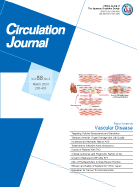88 巻, 3 号
選択された号の論文の28件中1~28を表示しています
- |<
- <
- 1
- >
- >|
Message From the Editor-in-Chief
-
原稿種別: MESSAGE FROM THE EDITOR-IN-CHIEF
2024 年 88 巻 3 号 p. 265-276
発行日: 2024/02/22
公開日: 2024/02/22
[早期公開] 公開日: 2024/02/07PDF形式でダウンロード (6797K) HTML形式で全画面表示
Focus on issue: Vascular Disease
Reviews
-
原稿種別: REVIEW
2024 年 88 巻 3 号 p. 277-284
発行日: 2024/02/22
公開日: 2024/02/22
[早期公開] 公開日: 2023/10/26PDF形式でダウンロード (733K) HTML形式で全画面表示
Original Articles
Aortic Disease
-
原稿種別: ORIGINAL ARTICLE
専門分野: Aortic Disease
2024 年 88 巻 3 号 p. 285-294
発行日: 2024/02/22
公開日: 2024/02/22
[早期公開] 公開日: 2023/12/19PDF形式でダウンロード (1950K) HTML形式で全画面表示 -
原稿種別: EDITORIAL
2024 年 88 巻 3 号 p. 295-296
発行日: 2024/02/22
公開日: 2024/02/22
[早期公開] 公開日: 2023/12/29PDF形式でダウンロード (320K) HTML形式で全画面表示 -
原稿種別: ORIGINAL ARTICLE
専門分野: Aortic Disease
2024 年 88 巻 3 号 p. 297-306
発行日: 2024/02/22
公開日: 2024/02/22
[早期公開] 公開日: 2023/09/07PDF形式でダウンロード (3828K) HTML形式で全画面表示 -
原稿種別: EDITORIAL
2024 年 88 巻 3 号 p. 307-308
発行日: 2024/02/22
公開日: 2024/02/22
[早期公開] 公開日: 2023/10/24PDF形式でダウンロード (898K) HTML形式で全画面表示 -
原稿種別: ORIGINAL ARTICLE
専門分野: Aortic Disease
2024 年 88 巻 3 号 p. 309-318
発行日: 2024/02/22
公開日: 2024/02/22
[早期公開] 公開日: 2023/08/29PDF形式でダウンロード (1457K) HTML形式で全画面表示
Peripheral Artery Disease
-
原稿種別: ORIGINAL ARTICLE
専門分野: Peripheral Artery Disease
2024 年 88 巻 3 号 p. 319-328
発行日: 2024/02/22
公開日: 2024/02/22
[早期公開] 公開日: 2023/07/07PDF形式でダウンロード (1364K) HTML形式で全画面表示 -
原稿種別: EDITORIAL
2024 年 88 巻 3 号 p. 329-330
発行日: 2024/02/22
公開日: 2024/02/22
[早期公開] 公開日: 2023/08/21PDF形式でダウンロード (489K) HTML形式で全画面表示 -
原稿種別: ORIGINAL ARTICLE
専門分野: Peripheral Artery Disease
2024 年 88 巻 3 号 p. 331-338
発行日: 2024/02/22
公開日: 2024/02/22
[早期公開] 公開日: 2023/08/04PDF形式でダウンロード (777K) HTML形式で全画面表示 -
原稿種別: EDITORIAL
2024 年 88 巻 3 号 p. 339-340
発行日: 2024/02/22
公開日: 2024/02/22
[早期公開] 公開日: 2023/09/23PDF形式でダウンロード (318K) HTML形式で全画面表示 -
原稿種別: ORIGINAL ARTICLE
専門分野: Peripheral Artery Disease
2024 年 88 巻 3 号 p. 341-350
発行日: 2024/02/22
公開日: 2024/02/22
[早期公開] 公開日: 2023/10/06PDF形式でダウンロード (1181K) HTML形式で全画面表示 -
原稿種別: ORIGINAL ARTICLE
専門分野: Peripheral Artery Disease
2024 年 88 巻 3 号 p. 351-358
発行日: 2024/02/22
公開日: 2024/02/22
[早期公開] 公開日: 2023/12/02PDF形式でダウンロード (1853K) HTML形式で全画面表示
Venous Thromboembolism
-
原稿種別: ORIGINAL ARTICLE
専門分野: Venous Thromboembolism
2024 年 88 巻 3 号 p. 359-368
発行日: 2024/02/22
公開日: 2024/02/22
[早期公開] 公開日: 2023/06/30PDF形式でダウンロード (1204K) HTML形式で全画面表示 -
原稿種別: EDITORIAL
2024 年 88 巻 3 号 p. 369-370
発行日: 2024/02/22
公開日: 2024/02/22
[早期公開] 公開日: 2023/09/06PDF形式でダウンロード (318K) HTML形式で全画面表示 -
原稿種別: ORIGINAL ARTICLE
専門分野: Venous Thromboembolism
2024 年 88 巻 3 号 p. 371-379
発行日: 2024/02/22
公開日: 2024/02/22
[早期公開] 公開日: 2023/12/23PDF形式でダウンロード (917K) HTML形式で全画面表示 -
原稿種別: EDITORIAL
2024 年 88 巻 3 号 p. 380-381
発行日: 2024/02/22
公開日: 2024/02/22
[早期公開] 公開日: 2024/02/01PDF形式でダウンロード (581K) HTML形式で全画面表示
Stroke
-
原稿種別: ORIGINAL ARTICLE
専門分野: Stroke
2024 年 88 巻 3 号 p. 382-387
発行日: 2024/02/22
公開日: 2024/02/22
[早期公開] 公開日: 2024/01/13PDF形式でダウンロード (486K) HTML形式で全画面表示 -
原稿種別: EDITORIAL
2024 年 88 巻 3 号 p. 388-389
発行日: 2024/02/22
公開日: 2024/02/22
[早期公開] 公開日: 2024/02/06PDF形式でダウンロード (627K) HTML形式で全画面表示
Population Science
-
原稿種別: ORIGINAL ARTICLE
専門分野: Population Science
2024 年 88 巻 3 号 p. 390-407
発行日: 2024/02/22
公開日: 2024/02/22
[早期公開] 公開日: 2023/12/11PDF形式でダウンロード (1855K) HTML形式で全画面表示 -
原稿種別: ORIGINAL ARTICLE
専門分野: Population Science
2024 年 88 巻 3 号 p. 408-416
発行日: 2024/02/22
公開日: 2024/02/22
[早期公開] 公開日: 2024/01/19PDF形式でダウンロード (3767K) HTML形式で全画面表示 -
原稿種別: ORIGINAL ARTICLE
専門分野: Population Science
2024 年 88 巻 3 号 p. 417-424
発行日: 2024/02/22
公開日: 2024/02/22
[早期公開] 公開日: 2024/01/23PDF形式でダウンロード (1559K) HTML形式で全画面表示
Basic Science
-
原稿種別: ORIGINAL ARTICLE
専門分野: Basic Science
2024 年 88 巻 3 号 p. 425-433
発行日: 2024/02/22
公開日: 2024/02/22
[早期公開] 公開日: 2023/11/25PDF形式でダウンロード (1767K) HTML形式で全画面表示
Images in Cardiovascular Medicine
-
原稿種別: IMAGES IN CARDIOVASCULAR MEDICINE
2024 年 88 巻 3 号 p. 434-
発行日: 2024/02/22
公開日: 2024/02/22
[早期公開] 公開日: 2024/01/11PDF形式でダウンロード (643K) HTML形式で全画面表示 -
原稿種別: IMAGES IN CARDIOVASCULAR MEDICINE
2024 年 88 巻 3 号 p. 435-
発行日: 2024/02/22
公開日: 2024/02/22
[早期公開] 公開日: 2024/01/06PDF形式でダウンロード (591K) HTML形式で全画面表示 -
原稿種別: IMAGES IN CARDIOVASCULAR MEDICINE
2024 年 88 巻 3 号 p. 436-
発行日: 2024/02/22
公開日: 2024/02/22
[早期公開] 公開日: 2024/01/19PDF形式でダウンロード (580K) HTML形式で全画面表示
-
2024 年 88 巻 3 号 p. Cover3-
発行日: 2024/02/22
公開日: 2024/02/22
PDF形式でダウンロード (408K) -
2024 年 88 巻 3 号 p. Content3-
発行日: 2024/02/22
公開日: 2024/02/22
PDF形式でダウンロード (818K)
- |<
- <
- 1
- >
- >|
